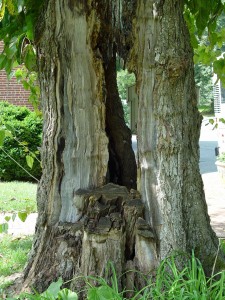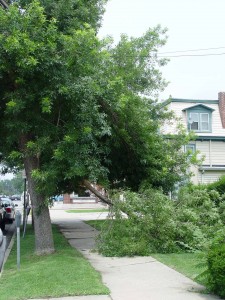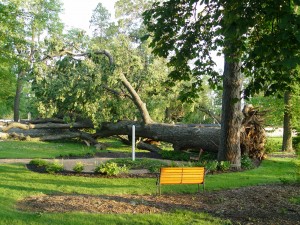When Trees Go Delinquent
June 10th, 2013
Bob Carey tells the story of the golfer who got hit by a falling tree branch, then sued the golf course for negligence.
The golfer claimed a litany of damages, starting with a torn rotator cuff and ending with blaming the tree for his erectile dysfunction.
The lawsuit wasn’t successful, but Carey – Hampden Twp. arborist and host of the Sunday “Garden Talk” radio show on WIOO in Carlisle – says it illustrates the sometimes rocky relationship we have with our branched brethren.
Trees are at the center of many a neighborly spat.
The neighbor’s branch overhanging your newly roofed garage… those honeylocust roots creeping into your garden… that scraggly, leaning maple that looks like it’s headed for your driveway the next storm…
“As I’ve learned over the years, sometimes these things aren’t easy to resolve with your neighbors,” says Carey. “A lot of people don’t even know their neighbors.”
Because of the many extreme storms we’ve had in the last few years, failing trees have been more of an issue than usual.
So what’s the answer? How do you get tree trouble resolved, especially when the tree-owner and the aggrieved neighbor don’t see eye to eye?
Carey and Carlisle attorney Karl Rominger did an interesting program on that at the Pennsylvania Garden Expo, fittingly titled, “I’m Calling the Cops About Your Tree!”
It turns out the law doesn’t give a lot of clear guidance.
Rominger says that’s because rulings come from common law rather than statute. In other words, prior court decisions guide the current case.
“The problem is, you get all of these different decisions because the facts in each case are a little different,” says Rominger. “That’s when the lawyers look for experts who will give advice that benefits their client.”
That makes it hard for lawyers and refereeing arborists to give clear-cut, up-front recommendations. A ruling could go either way, depending on how a judge views the opposing arguments.
“A lot of small matters aren’t worth hiring a lawyer,” Rominger says. “You’re likely to spend more on legal fees than you recover in damages.”
That’s why Carey tries to get neighbors to work out a solution.
When the neighbor’s sweetgum is hanging over your fence and dropping those spiky seed balls, for example, Carey says the best course is a civil discussion.
“You can trim branches back to the line, but I always tell people to ask your neighbor first if that’s OK,” says Carey.
Rominger says the law is usually on your side in a case like this, so long as you don’t trespass into your neighbor’s yard to do the cutting and you don’t cut in a reckless or “non-negligent” manner.
“If the tree dies after you cut it, you may still be liable even if you didn’t trespass,” Rominger says.
Carey says that if the neighbor can’t or won’t cut his own tree branches, you could give him the name of some companies that will do the work.
Rominger adds that if you really want the branches gone and don’t want to risk getting into trouble by harming the tree, the most practical solution might be to offer to hire a pro and pay the tab yourself.
Creeping roots pose a similar problem. Neighbors often get annoyed when someone else’s tulip poplar, Norway maple or black walnut sends out surface roots that kill their lawn or stunt their garden plants.
“People feel like they have a right to cut those roots,” says Carey, “but that opens up the opportunity for root rot that can lead to structural damage to the tree.”
Then it becomes a dispute over who’s liable for what.
“If you cut the roots, first hope that you don’t kill the tree,” says Rominger. “If it dies soon afterward, you’re probably liable. If it dies 5 years down the road, you’re probably not.”
Most serious is the threat of a failing tree that could fall onto a house, car or person.
It’s not unusual for some people to ignore even dead trees, which are likely coming down sooner rather than later.
However, it’s not always apparent which trees are going to fail. Sometimes even healthy trees blow over when the wind blows hard enough, especially following root-loosening, soaking rains.
Rominger says this one boils down, at least legally, into what a “reasonably prudent person” should have done.

A “reasonably prudent” person should know that this tree is coming down — most likely sooner rather than later.
On the one hand, he says common law generally lets you off the hook for damages caused by “naturally occurring” property.
“If something is considered naturally occurring on your property and the wind blows it over, it’s not your problem,” he says. “But it’s a different story if you have specific knowledge of a problem and don’t do anything about it. It’s kind of like the garden of Eden. It’s getting that knowledge that creates the sin.”
That’s another reason Carey advocates bringing potential problems to the neighbor’s attention.
If you say nothing and a tree blows over, the neighbor can argue that it was an “act of God” and that he had no way of knowing it was going to fail.
But if you mention your concerns and point out dead limbs, a worsening lean or other early signs of potentially hazard trees, that’s a game-changer.
Carey says he often is hired to do reports on just such situations. Armed with a report from an arborist outlining hazards, a home-owner can give that information to the neighbor – maybe even with the names of tree companies suggested by the consulting arborist.
Of course, keeping trees well away from property lines in the first place is the best long-term solution.
Some municipalities now even have ordinances spelling out minimum setbacks for trees near property lines.
“Border trees cause more anxiety among tree-owners than anything else,” says Carey. “If you’re going to plant trees to screen or as windbreak, don’t plant them on the property line.”
The cops have enough to do without investigating delinquent trees.









